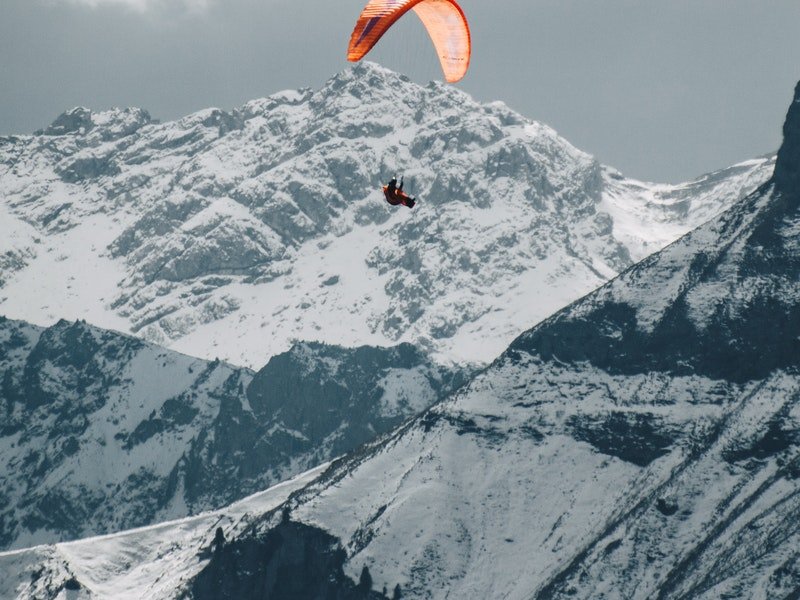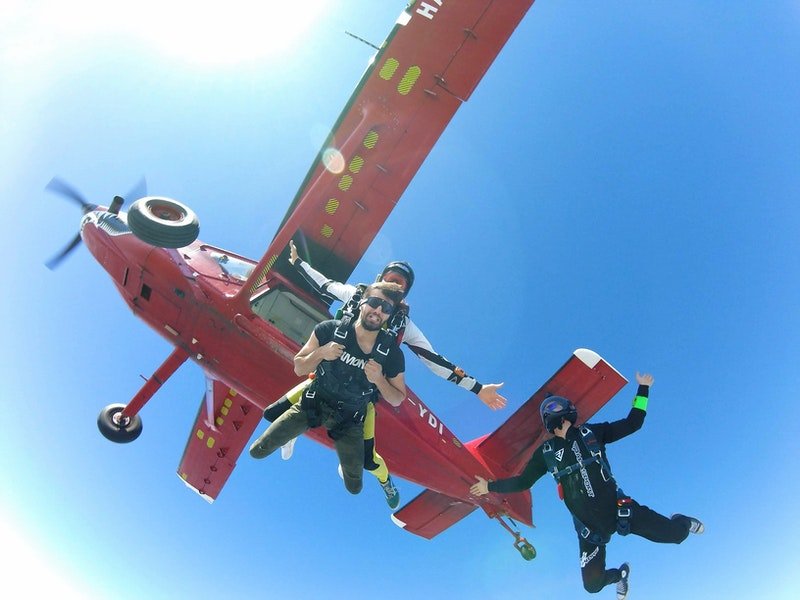Is there a difference between base jumping and skydiving? Skydiving, parachuting, and freefalling are interchangeable terms; used to describe the act of jumping and descending from great heights. But when people use the term ‘base jumping’ they are referring to something very specific.
To get to the heart of what the difference is between base jumping and skydiving we need to look at a few things: the techniques, the equipment, and the dangers.
The basic principles of base jumping and skydiving are very similar, but there are also some important differences. As well as using different equipment, the risks and dangers are poles apart. And while a base jumper should first become an accomplished skydiver, very few skydivers will go on to base jump. And here’s why…
What is the difference between base jumping and skydiving?

Skydiving is a sport where people jump and descend from great heights: usually done by jumping from a plane at altitudes of over 10,000 feet. They involve a freefall of around 7,000 feet, followed by a parachute descent for the last 3,000 feet.
Base jumping is a very different animal and s usually performed at much lower heights. Base jumps must also be from a fixed object. The word ‘base’ is an acronym, which stands for those four types of objects: buildings (towers and skyscrapers), antennae (radio towers), spans (bridges), earth (cliffs and mountains).
The term ‘base jump’ was first coined by Carl Boensih in 1978. Carl was an extreme filmmaker and one of the pioneers behind the sport. Using ram-air parachutes he and a group of friends would jump from El Capitan, in Yosemite National Park. For many, this was the birth of base jumping as we know it today.
A typical base jump can be as low as 300 to 500 feet, with some even going below 150 feet. To put that into better context; the U.S. Parachute Association recommends a class D skydiver to pull their parachute before 2,000 feet (it takes 600 to 1,200 feet for a standard parachute to fully open!).
Do you use a parachute in BASE jumping?

The equipment and parachutes used for base jumping are very different from those used in skydiving. Safety is at the heart of standard skydiving equipment, as well as having the main shoot, a skydiver will also have a reliable reserve in case of an emergency. In contrast to this, base jumpers only use one parachute, which is designed to open as fast and accurately as possible.
When base jumping first started jumpers would modify standard skydiving gear, usually by removing the deployment bag and slider. Since growing in popularity, you can now purchase specialist base jumping equipment. Such specialist equipment lessens the chance of broken lines or line-overs, but it’s still far from being a safe sport.
A modern base jump parachute is wing-loaded and much larger than a skydiving parachute. It will usually have vents and use an extra-large pilot chute to overcome the airspeeds at low altitudes.
There are also wingsuit base jumps, which don’t use parachutes. French skydiver, Patrick de Gayardon, is widely regarded as the creator of wingsuit base jumping. His first wingsuit base jumps were in 1997.
Can you base jump without skydiving?

When people say skydiving they are often referring to the freefall part of the skydive. Freefall is considered to be an adrenaline rush; especially those few seconds of freefall acceleration before hitting terminal velocity. So while there is an element of freefalling involved in base jumping, given the low heights, it can be very brief.
Skydivers freefall at approximately 200 feet per second. On a skydive over 10,000 feet, there will be 30 to 45 seconds of freefall before the parachute must be deployed. With base jumping the freefall can be as short as a few seconds, and on extremely low base jumps there is little to no canopy time: here equipment such as a static line or direct bag must be used. Super low base divers often jump with the parachute already out!
A lot of base jumpers want an element of freefall and so prefer higher objects to jump from. With some base jump locations being over 3,000 feet, it’s possible for a base jumper to reach terminal velocity.
What are the highest and lowest recorded base jumps?

Some of the highest base jumps are actually done at typical skydiving altitudes. In fact, the highest base jump on record was performant 25,300 feet! It was set by Russian extreme skydiver, Valery Rozov, off Cho Oyu mountain, in Nepal, in 2016.
In stark contrast to that, the lowest based jump currently on record was just 95 feet! It was complete by Austrian daredevil Felix Baumgartner (yes, the same person who did the famous Rebull Stratos jump). Felix made his base jump off the icon Christ the Redeemer statue in Rio De Janeiro.
Is BASE jumping more dangerous than skydiving?

It’s a myth that skydiving is a dangerous sport. Today skydiving is well regulated with lots of emphasis on safety and accessibility. Skydiving organizations are held to the highest standards, with equipment regularly tested and inspected. But while professionally supervised skydiving is a very safe sport, base jumping is certainly not.
Even the most experienced professional skydivers would never attempt base jumping, due to the risks. For starters, base jumpers only use one parachute, which is usually held in a very simple backpack; unlike the highly sophisticated packing and rigging of standard skydive parachute – which also has an equally sophisticated backup). While skydiving is highly regulated, base jumping is not, and there is no official organization that approves base jumping equipment.
The drops in base jumping are often so short, that when there is a problem there is almost no time to react or fix the issue. There is also the added risk that you are jumping next to a fixed object and collisions are not uncommon; it’s estimated that base jumping is 100 times riskier than skydiving.
Is it legal to BASE jump?

Technically, base jumping is not illegal; very few countries or regions ban the act of base jumping. Legal issues occur due to the base jumping locations, with most base jumps done without permission. This has caused base jumping to get a bad reputation, due to so many jumps involving trespassing.
There are some iconic buildings and landmarks where base jumping is permitted; the Perrine Bridge in Idaho is one good example. There are also a large number of natural base jumping points where it is legal and popular: the French Alps is one such location. However, there are also some areas where it isn’t: in the United States National Parks base jumping is prohibited.
Many regard Austria as being the spiritual home of base jumping, and in recent years the country has laid out jumping laws; jumping from mountains and cliffs is generally permitted, but many man-made structures, such as bridges and damn are not allowed.

